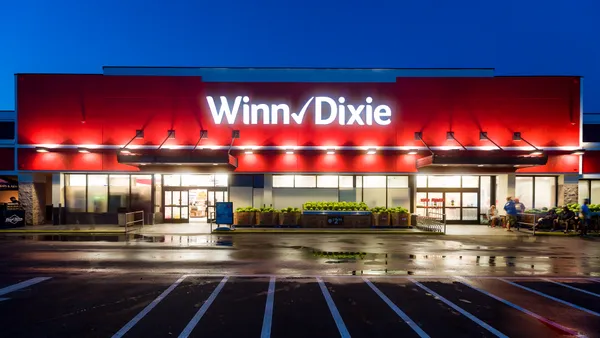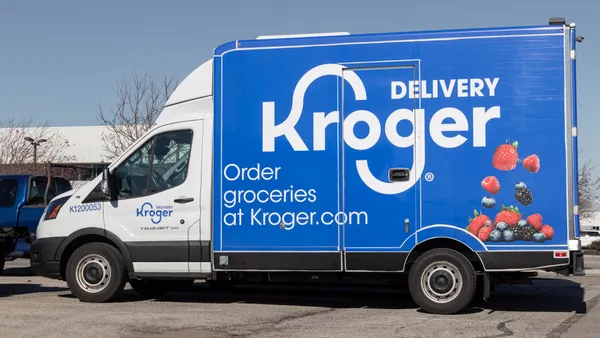Dive Brief:
-
Amazon reported $4.4 billion in physical store sales, of which Whole Foods makes up the vast majority, during its fourth financial quarter — a 3% drop over the same period last year. This was the first year-over-year comparison available since Amazon acquired the specialty grocer in June 2017.
-
According to Amazon executives, the sales drop doesn't factor in online sales along with a calendar change. Whole Foods' fiscal calendar included five extra days in last year's Q4, while physical store sales didn't factor in Whole Foods' Prime delivery and pickup orders, which were categorized under online sales.
-
Amazon said fourth quarter net sales rose 20% to $72.4 billion from $60.5 billion in the year-ago quarter; North America net sales rose 18% to $44.1 billion. Services sales rises overshadowed product net sales growth, as subscriptions rose 25% to $3.96 billion, "other" (mostly advertising, according to executives) rose 95% to $3.39 billion and AWS cloud computing sales rose 45% to $7.43 billion.
Dive Insight:
Viewed one way, the adjusted 6% growth for brick-and-mortar stores in Q4 is a worrying sign for Amazon, which by numerous accounts was expected to make swift and dramatic gains with Whole Foods on its way to industry dominance.
But the reality is that Whole Foods was a troubled business before the acquisition, and getting it back to the growth it saw a decade ago will take time — and may not even be possible. Amazon, a company known for its willingness to post losses and play the long game, is no doubt content to post modest gains as it works to transform the business.
Since taking over Whole Foods, Amazon has lowered prices and offered promotions through its Prime loyalty platform. It has also moved to streamline the grocer's sourcing practices, putting more emphasis on scalable and mainstream brands, according to reports.
On the e-commerce side of the business, has rolled out Prime delivery to 60 markets and pickup to 20 markets in an effort to build out its own platform. In December, the company ended its relationship with Instacart.
Yesterday's results suggest "large market share gains for Amazon in grocery," according to Wolfe Research analyst Scott Mushkin, who wrote in a note to clients that Whole Foods' steady price drops are gaining traction.
But others claim Amazon is still not adequately addressing Whole Foods' "whole paycheck" image
"Basics and commodity products still cost way more than at rivals like Target, and this is one of the reasons perceptions that Whole Foods is needlessly expensive have persisted," Neil Saunders, managing director with GlobalData Retail, wrote in a note emailed to Grocery Dive. "Such expense is not justified by store experience nor by customer service, both of which remain lackluster."
Amazon Go stores, which have eight locations and are also included in Amazon's physical store sales, are rapidly expanding and could also serve as an innovation lab for Whole Foods. Some observers believe Whole Foods will eventually integrate the cashier-free technology into its stores, despite Amazon's claim it isn't planning to do so.
Overall, it's getting more difficult to perceive Amazon as a retailer. The company's retail muscle is flexing more in delivery, fulfillment and sales of its own devices, while sales growth in its marketplace (where it's emphasizing its small and medium sellers) and its many services continue to outpace sales through its own channel.
Chief financial officer Brian Olsavsky, addressing analysts during a conference call on Thursday, demonstrated how the company sees its retail operation circling back to aid its own ecosystem when he said, after noting that Amazon Web Services, third party units and advertising sales are growing well: "Retail was very strong — the Echo Dot was the highest selling unit globally."
Amazon has long been widely seen as a tech company as much as a retailer, and that may be more true than ever — it's just that there are more services added into the mix.
But Amazon is facing new challenges as a retailer as well, Saunders said. Its maturity at more than two decades old (naturally tamping down the rapidity of initial growth), plus great strides taken by rivals, are pressuring sales.
"Retailers like Target and Walmart have invested heavily in their online operations and pulled out all the stops this holiday season," he said. "Our data show that they made solid customer gains, and some of that dinted Amazon's growth. In our view, the gap between Amazon and the rest is now narrowing."












